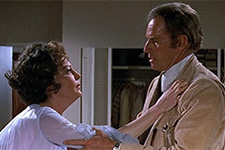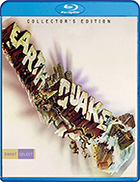Earthquake
|  Rushed into production and completed at breakneck speed in order to beat the competing disaster epic The Towering Inferno (1974) to theaters (which it did … by a month), Mark Robson’s Earthquake is an archetype of its genre, although that doesn’t necessarily make it a good movie. A “what if?” disaster epic about a massive quake shaking Los Angeles to rubble, it was bestowed with multiple Oscars for its visual effects and sound design, which at the time were a mixture of the groundbreaking (Sensurround!) and a copious deployment of old Hollywood tricks dating back to the silent era. It is a masterclass of matte paintings and miniatures, although many of the optical effects have not dated well and the whole thing has a fakey feel so that you’re never convinced you’re watching anything other than a cavalcade of special effects. A major part of the problem is the drama, which is silly and limp, a going-through-the-motions sham that relies heavily on tired formula. Director Mark Robson began his career as an editor, working with Robert Wise on Orson Welles’s Citizen Kane (1941) and The Magnificent Ambersons (1942) before directing superior, low-key horror films for producer Val Lewton like The Seventh Victim (1943) and Isle of the Dead (1945). He had been nominated for Best Director Oscars for Peyton Place (1957) and The Inn of the Sixth Happiness (1958) and had directed the socially progressive war film Home of the Brave (1949) for producer Stanley Kramer, but by the time he helmed Earthquake, his penultimate film, he was probably best known for the campy hit Valley of the Dolls (1967), whose leaden drama and uneven tone foretold the messiness of Eathquake’s confused dramatics. Following in the footsteps of Airport (1970) and The Poseidon Adventure (1972), which helped to establish the parameters of the disaster genre that was so popular throughout the 1970s, Earthquake spreads its narrative across a wide range of characters. What makes Earthquake unique, though, is how disagreeable and unsympathetic many of its characters are, beginning with the ostensible protagonist, Graff (Charlton Heston), a burly engineer who is trapped in a miserable marriage to Remy (Ava Gardner), an unpleasant, narrow-eyed drama queen who fakes (poorly) her own suicide in the opening scene to get his attention. Graff feels trapped because he is employed by Remy’s wealthy father, Royce (Lorne Green), and his attention is increasingly drawn to Denise (Geneviève Bujold), a young, single mother and aspiring actress. Remy is insufferable in her attention-seeking charades and constant glaring, but there is a truly odious whiff of misogyny in the way she is portrayed as the villain while Graff, who is every bit her equal in awfulness, is presented as a long-suffering hero. Heston, who had reinvented himself in the early ’70s in films like Planet of the Apes (1968) and Soylent Green (1972), is given too much star power, while Gardner, in her fading years, deserves much better. When we aren’t mired in the sad-sack dynamics of Graff and Remy’s miserable and profoundly uninteresting marriage, the screenplay by George Fox and Mario Puzo (the latter of whom had to leave early to work on The Godfather Part II) throws together a few vaguely interconnected subplots involving a host of other characters, including Slade, a no-nonsense police officer (George Kennedy); Miles, a stunt motorcyclist who models himself on Evel Knievel (Richard Roundtree); Miles’s manager (Gabriel Dell); his manager’s sister, Rosa (Victoria Principle), and Jody, a grocery store supervisor (Marjoe Gortner) who is also a member of the National Guard and a budding psychopath. Most of these are characters are stock players, culled from a list of “typical” denizens of a big city, each representing a type and filling screen space. The one exception is Jody, who is such an intensely weird and provocative character that he feels like he was imported wholesale from another film. Part of his weirdness is that he is played by Marjoe Gortner, who had already achieved cultural infamy as a fiery Pentecostal preacher about whom an Oscar-winning documentary had been made just a few years earlier (1972’s Marjoe). Gortner has wild eyes and wild hair and a creepy air, and he plays the proverbial bullied victim (he is taunted by a trio of alpha males who accuse him of being gay) who gets to unleash all his repressed rage once the earthquake hits and all the normal rules cease to apply. His rage is directly murderous and sexually violent, and it is all too much for this otherwise silly enterprise. And that brings us to the earthquake itself, which takes up about 11 minutes of screen time at almost exactly the halfway point of the movie, where theaters were literally shaken by Sensurround, a proprietary new sound design technology that basically amounted to huge subwoofers rattling the audience. More than a few critics at the time suggested that Earthquake was Hollywood’s ultimate act of self-loathing, tearing down the very city in which it was based and reducing every iconic location—from the Hollywood Dam, to the Capitol Records Building—to smoldering ruins (the irony is that virtually the entire film was shot on the Universal backlot, with familiar locations literally a mile away recreated with matte paintings and miniatures). The destruction is duly impressive, balancing a gee-whiz appreciation of the special effects artistry with some nods toward the severity of the carnage. Sometimes this works, and we feel a gnawing sense of terror as we project ourselves into the harrowing scenario, and at other points it is just hokey, such as when an elevator full of people crashing to their deaths is punctuated by a clearly animated splatter of blood right into the camera lens. Buildings collapse, dams fail, fire and smoke abound, all with carefully composed optics that encourage you to revel in the ruin. But, for all the bodies falling and crushed when “the big one” hits, there is never really anything at stake other than whether or not we are convinced by the effects (this is underscored by the distracting presence of Walter Matthau in a wordless—and needless—cameo as a drunk in a pimp costume comically surviving the chaos by doing nothing). Some of Earthquake’s best scenes are the sustained moments of suspense created by characters trying to escape the ruins, the best being Graff and Royce lowering people down several floors in a partially collapsed skyscraper using a firehose and a desk chair while noxious gas spews all around them. In a better movie Graff’s heroics—of which there are many—would somehow redeem his character or at least given him additional dimensions, but here it plays like a stipulation in Heston’s contract: “must save many people in lasting fit of self-effacing heroics.” Earthquake isn’t as cynically downbeat as The Cassandra Crossing (1976) in its brutal sacrifice of innocent civilians, but it certainly winds its way toward an ending that is more resigned to loss any sense of optimism about the future. “This used to be a helluva of a town,” a character intones in the final moment. What a send-off.
Copyright © 2022 James Kendrick Thoughts? E-mail James Kendrick All images copyright © Shout! Factory | |||||||||||||||||||||||||||||
Overall Rating: 
 (2)
(2)


